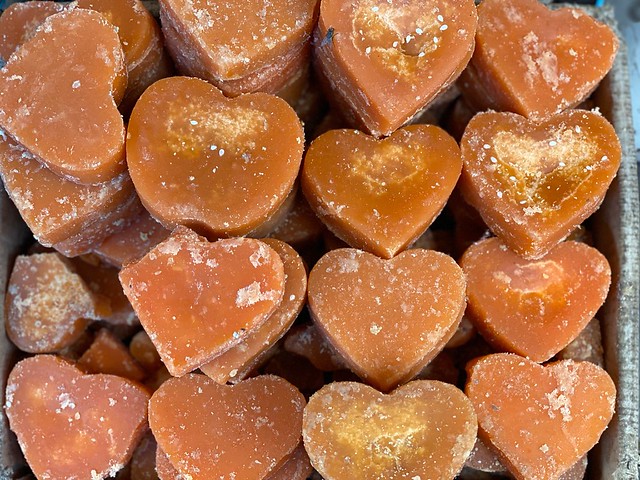
City Food – The World of Gur, Sadar Bazar, Gurgaon

The other sweet.
[Text and photos by Mayank Austen Soofi]
There are people who can identify a great number of birds by their names. Some have an encyclopedic insight on butterflies. Others are big on flowers. An environmentalist in Delhi rustled out a book on all the trees found in the city.
And then there are experts on gur.
Most of us who are fond of jaggery see it uniformly as a lumpy brown mass of unrefined sugar. But the world of gur is a cacophonous democracy. Pankaj Traders, a 70-year-old grocery in Gurgaon’s Sadar Bazar in the Greater Delhi Region, stocks half a dozen kinds of jaggery. This afternoon they are neatly arranged outside the shop’s counter. One variety is encrusted with peanuts. Another is heart-shaped. The most impressive is looking like a little mound of earth.
“This range is available only in winters,” shouts grocer Pankaj Gupta from behind the counter. He is busy with a nonstop stream of customers. The rest of the year the shop is left with only two varieties, he points out, adding that Delhi region gets its gur from towns in UP such as Muzaffarnagar and Murad Nagar.
Meanwhile, the shop’s jaggery corner is getting steady patrons. Strangely, not one customer is able to name these varieties. They are selecting the gur by simply pointing out their choice to the shop assistants who too don’t know the names. Finally, Mr Gupta excuses himself from the counter and walks out towards the jaggery stack.
Starting clockwise from right, he names all of them in a single breath as if reciting the many names of god—pedi, batasha, papri, moongphali, chaku, dahiya, paneer.
Rushing back to his post, he warns that these varieties, each with a distinct flavour, shall last from December to March. After which, the city will again be reduced to a jaggery drought.
Death by jaggery
1.
2.
3.
4.
5.
6.
7.
8.
9.
10.











Pic 1 and 2:
The one in the top right corner and also in the 7th picture, that shape/style is called “bheli” (भेल्ली).
The shape of gur in 3 treys in the veritcal middle row is called “dala” (डळा).
The shape of gur in 2 treys in the right most vertical row is called “khurpa paad” (खुरपा पाड़), since its chopped into pieces while semi solid with the help of ‘khurpa” (hoe or shovel), see also Khurpa (https://en.wikipedia.org/wiki/Khurpa).
Reminds of the popular Haryanvi idioms:
1. JAT mange te ganda na de, bina mange bhelii de de (जाट मांगे तें गंडा ना दे, बिना मांगे भेल्ली देदे), meaning “do not insist upon a Jat to give you what you are unworthy of, if you have patience he might just reward you amply” i.e. don’t ever force a Jat.
2. Gande te ganderi meethi, gur te meetha lalla, Bhai re bhatija pyara, ar sab te pyara saala (गंडे तें गंडेरी मीठी, गुड़ तें मीठा लाळा, भाई तें भतीजा प्यारा, अर सब तें प्यारा साळा). Lalla is the semi solid gur during the process of making, i.e. the condensed sugarcane juice or molasses. Ganda is sugercane. Ganderi is a bite size piece of sugarcane.